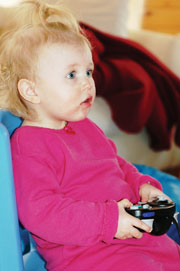Is your preschooler begging for a Nintendo DS for her birthday? With video games being marketed to preschoolers — and featuring their favorite toys and movies — how can you evaluate what (if any!) video game systems and games are appropriate or even just OK for your child?
Fortunately, a lot of parents face this question, and John Davison, president of the San Francisco-based Web site What They Like (www.whattheylike.com), makes it his job to give parents all the info they need to make these tricky (and often stressful) decisions. 
So how do you figure out if video games, especially those labeled “educational,” are good or bad for your kid’s development? Davison says that there is a lot that young children can learn from video games, and yes, there are some quality games targeted to this age group. “By wrapping simple comprehension and analytical challenges in experiences that are fun, and often using familiar franchises, kids are able to absorb concepts very quickly,” he says.
But don’t rush out just yet to buy your kids’ favorite titles. Bellevue pediatrician Dr. Jean Sahs says that “screen time is screen time” and needs to be limited. This means that whether it’s TV, a computer or video games, it has some impact on your child’s brain and should account for a very small portion of his day. She says that, especially for children ages 2 and younger, just like TV, the video images are way too much for them to process. Also, if they are playing video games, they are not doing other important things to help their physical, mental and emotional development.
The debate
Davison believes that quality games help children with counting, letter recognition and spelling. “But beyond that, the interactive nature means that they’re exploring cognitive skills too,” Davison says. “Preschool-age kids absorb information like sponges, and they’ll quickly memorize passages of speech, and songs, and later you’ll see this turn up in their comprehension of logic too. Pattern recognition is a cinch for kids, if given the proper stimuli.”
Dr. Sahs strongly disagrees. She knows that marketers and even some parents tout the benefits and educational aspects of video games. But she reminds parents that for preschoolers, doing puzzles and building with blocks have the same benefits. For the young child, the biggest detriment of playing video games is that while they are playing, they are not communicating, Sahs says. Whereas with a simple board game, parents and children laugh, talk and interact.
Dr. Sahs says that of all the game systems on the market for the preschool-age child, she thinks that Leapster is probably the least harmful. But she reminds parents not to be fooled; a lot of the games have no quality at all and are just “glorified, reduced-down GameBoys.”
What’s available
There’s an ever-increasing variety of games for this age group available for Mac and PC platforms, as well as for the Nintendo DS handheld unit, which features a touch-screen interface. “There are a lot of both packaged and Web-based products that are very good,” Davison says, “stuff like the Dora the Explorer games. The browser games on the Disney and Nick sites are great for preschoolers too, and they’re free.”
As many parents know, kids love these games that are designed especially for them. They like learning how to work the family computer and having an interactive experience that rewards them. They like learning how to use the mouse and the touch screen on some of the other devices.
Davison says that a lot of publishers are eager to expand their markets and explore new audiences, so he thinks there may be more games and game consoles on the horizon aimed specifically at the very young gamer in the near future. He also sees publishers making a very concerted effort to create games specifically for girls.
“I think you can look at things two different ways: There are games that are very much aimed at young children, with specific educational goals built in, and then there are games that are fun and kids will enjoy — and the benefits are a little different,” Davison says. “I have two young boys, and they’re both very interested in video games, because, well, Dad is surrounded by the stuff at all times, and it’s a big part of our family culture. My oldest boy is 4 and has recently taken a huge interest in football. He loves watching it, he loves throwing a ball around in the backyard, and he loves playing Madden NFL ‘08 on the Wii.”
The Seattle market is a hotbed of video game development and publishing, and one company, Sandlot (www.sandlotgames.com), features an array of family-friendly titles. According to Daniel Bernstein, CEO, the company receives feedback frequently from grandparents who enjoy playing the games with their grandchildren.
Two of Sandlot’s games, Cake Mania (2006) and Burger Island (2007), were both recognized by the iParenting Media Awards as an Outstanding Product. The iParenting Media Awards were created to provide a credible and objective method of determining the best family-friendly products in the marketplace. It is the only consumer awards program that has achieved an ISO 9001:2000 certification, an internationally recognized standard for quality assurance.
“We don’t necessarily target our games to children, but it is always encouraging when games we thought were too difficult for preschoolers are actually very appropriate for them,” says Bernstein. “We also find it interesting that parents and children work together to solve some of the more difficult levels. It’s my belief that if you challenge a child and don’t make assumptions about his or her capabilities, they will surprise you with their adaptability and intelligence.”
According to a survey by PopCap Games, 92 percent of adult “family gamers” said they felt casual games provided an opportunity to bond with or better relate to their children. With today’s prevalence of violent video games, casual family-friendly games offer an alternative that can be played by all ages.
No matter what your position on video games for preschoolers, experts agree that close monitoring of content and time spent in front of a screen are critical to our children’s health, development and well-being.
Dr. Sahs’ own 10-year-old must earn time on his Nintendo DS -- and then, only during summer. During the school year, the system is used strictly during air travel. “It’s mine to give or not to give,” Sahs says. “Parents need to feel that it’s OK to say no.”
Karen Dawson, owner of Dawson Communications Group, is the mother of two children.
HOW TO INTERPRET GAME RATINGS
The Entertainment Software Rating Board (ESRB) is a non-profit agency that assigns ratings to electronic games. According to Sandlot Games CEO Dainel Bernstein, ESRB ratings include additional information that can give parents more insight into what type of content their child can expect to see in any given game. “For example, a game might be rated 'E' for all [audiences] but still might include some 'comic mischief' or reference to alcohol and tobacco, for example,” says Bernstein. “Our best advice to parents is to review the game carefully, check the ESRB rating, see what review sites are saying about the game and what gamers themselves are saying about the game.” Finally, Bernstein says, the parent may want to play the game with the child to see if there is any inappropriate content. “We design our games to be kid-friendly, since so many kids play them with their parents,” Bernstein says.
Check out these Web sites for more information:
www.iparenting.com
www.whattheylike.com
www.iparentingmediaawards.com
www.esrb.com
www.aap.com









